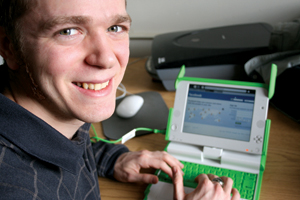
Two Binghamton University students are fixing and designing software that helps both their classmates and the world.
Crash Test Dummy …
Benjamin Kreuter, a senior electrical engineering and computer science major, is a volunteer software tester for One Laptop Per Child (OLPC).
Formed in 2005, OLPC is an American non-profit organization that has distributed over one million XO-1 laptops (also known as hundred-dollar laptops) to developing countries. XO-1 is run on a Linux variation, Fedora, with an interface called Sugar. It’s designed for simplicity, as some of the laptop’s users might never have seen a computer before.
Last week programmers got the alpha version of the newest Fedora operating system, Fedora 11, installed on XO-1 laptops.
Kreuter was experimenting with the new operating system when he noticed that the e-book reader would crash after opening large books and PDF files. As a tester, his assignment is finding this problem’s solution.
“You can’t have software randomly crashing on people,” Kreuter said.
Kreuter said he believes the system runs out of memory to load the files, which causes the crashes.
“If this is the case, I’d have to spend a month or so trying various tricks, such as loading fewer pages, pieces of pages or reducing the program’s memory footprint,” he said.
The XO-1 can connect to the Internet through a cloud system, where one user can distribute content to others in the area.
When connected, textbooks and documents can be accessed for free from sources such as Wikibooks.
OLPC members hope to one day implement e-book reader into e-book mode, which dims the screen to conserve power for extended periods of reading time after folding the screen backwards to emulate the feel of a book.
The foldable screen is one of only three moving parts in the laptop, for increased durability.
“We could send these to someplace in the Sahara, and you don’t want to get sand caught inside a fan or hard drive,” Kreuter said.
Matrix … Inverted
Michael Jabaji, a senior computer science major, wrote two programs to assist classmates in his MATH 304 class, Linear Algebra.
Students work with matrices in the class, which are grids of data containing answers to linear equations based on various parameters.
Jabaji’s programs allow students to multiply and invert matrices, a part of linear algebra.
Students can input equations and, with a simple click, see how answers are formulated.
“I felt that the book offered solutions on how to solve these equations, but it wasn’t enough,” Jabaji said. “These programs show you step-by-step the why and how of each problem.”
Jabaji wrote the programs in an hour using algorithms from the textbook.
“An equation is sent through 344 lines of code before reaching a solution,” he said.
Gina Kucinski, professor of the class, was pleased with Jabaji’s creations, and uploaded the tools onto Blackboard for her students’ use.


